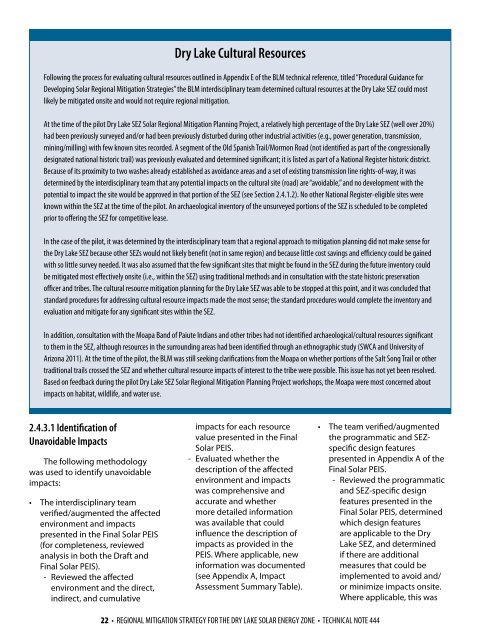xs7hy9e06w?redirect_to=http://www.blm.gov/pgdata/etc/medialib/blm/wo/blm_library/tech_notes.Par.29872.File.dat/TN_444
xs7hy9e06w?redirect_to=http://www.blm.gov/pgdata/etc/medialib/blm/wo/blm_library/tech_notes.Par.29872.File.dat/TN_444
xs7hy9e06w?redirect_to=http://www.blm.gov/pgdata/etc/medialib/blm/wo/blm_library/tech_notes.Par.29872.File.dat/TN_444
You also want an ePaper? Increase the reach of your titles
YUMPU automatically turns print PDFs into web optimized ePapers that Google loves.
Dry Lake Cultural Resources<br />
Following the process for evaluating cultural resources outlined in Appendix E of the BLM <strong>tech</strong>nical reference, titled “Procedural Guidance for<br />
Developing Solar Regional Mitigation Strategies” the BLM interdisciplinary team determined cultural resources at the Dry Lake SEZ could most<br />
likely be mitigated onsite and <strong>wo</strong>uld not require regional mitigation.<br />
At the time of the pilot Dry Lake SEZ Solar Regional Mitigation Planning Project, a relatively high percentage of the Dry Lake SEZ (well over 20%)<br />
had been previously surveyed and/or had been previously disturbed during other industrial activities (e.g., power generation, transmission,<br />
mining/milling) with few known sites recorded. A segment of the Old Spanish Trail/Mormon Road (not identified as part of the congressionally<br />
designated national historic trail) was previously evaluated and determined significant; it is listed as part of a National Register historic district.<br />
Because of its proximity to t<strong>wo</strong> washes already established as avoidance areas and a set of existing transmission line rights-of-way, it was<br />
determined by the interdisciplinary team that any potential impacts on the cultural site (road) are “avoidable,” and no development with the<br />
potential to impact the site <strong>wo</strong>uld be approved in that portion of the SEZ (see Section 2.4.1.2). No other National Register-eligible sites were<br />
known within the SEZ at the time of the pilot. An archaeological inventory of the unsurveyed portions of the SEZ is scheduled to be completed<br />
prior to offering the SEZ for competitive lease.<br />
In the case of the pilot, it was determined by the interdisciplinary team that a regional approach to mitigation planning did not make sense for<br />
the Dry Lake SEZ because other SEZs <strong>wo</strong>uld not likely benefit (not in same region) and because little cost savings and efficiency could be gained<br />
with so little survey needed. It was also assumed that the few significant sites that might be found in the SEZ during the future inventory could<br />
be mitigated most effectively onsite (i.e., within the SEZ) using traditional methods and in consultation with the state historic preservation<br />
officer and tribes. The cultural resource mitigation planning for the Dry Lake SEZ was able to be stopped at this point, and it was concluded that<br />
standard procedures for addressing cultural resource impacts made the most sense; the standard procedures <strong>wo</strong>uld complete the inventory and<br />
evaluation and mitigate for any significant sites within the SEZ.<br />
In addition, consultation with the Moapa Band of Paiute Indians and other tribes had not identified archaeological/cultural resources significant<br />
to them in the SEZ, although resources in the surrounding areas had been identified through an ethnographic study (SWCA and University of<br />
Arizona 2011). At the time of the pilot, the BLM was still seeking clarifications from the Moapa on whether portions of the Salt Song Trail or other<br />
traditional trails crossed the SEZ and whether cultural resource impacts of interest to the tribe were possible. This issue has not yet been resolved.<br />
Based on feedback during the pilot Dry Lake SEZ Solar Regional Mitigation Planning Project <strong>wo</strong>rkshops, the Moapa were most concerned about<br />
impacts on habitat, wildlife, and water use.<br />
2.4.3.1 Identification of<br />
Unavoidable Impacts<br />
The following methodology<br />
was used to identify unavoidable<br />
impacts:<br />
• The interdisciplinary team<br />
verified/augmented the affected<br />
environment and impacts<br />
presented in the Final Solar PEIS<br />
(for completeness, reviewed<br />
analysis in both the Draft and<br />
Final Solar PEIS).<br />
- Reviewed the affected<br />
environment and the direct,<br />
indirect, and cumulative<br />
impacts for each resource<br />
value presented in the Final<br />
Solar PEIS.<br />
- Evaluated whether the<br />
description of the affected<br />
environment and impacts<br />
was comprehensive and<br />
accurate and whether<br />
more detailed information<br />
was available that could<br />
influence the description of<br />
impacts as provided in the<br />
PEIS. Where applicable, new<br />
information was documented<br />
(see Appendix A, Impact<br />
Assessment Summary Table).<br />
• The team verified/augmented<br />
the programmatic and SEZspecific<br />
design features<br />
presented in Appendix A of the<br />
Final Solar PEIS.<br />
- Reviewed the programmatic<br />
and SEZ-specific design<br />
features presented in the<br />
Final Solar PEIS, determined<br />
which design features<br />
are applicable to the Dry<br />
Lake SEZ, and determined<br />
if there are additional<br />
measures that could be<br />
implemented to avoid and/<br />
or minimize impacts onsite.<br />
Where applicable, this was<br />
22 • REGIONAL MITIGATION STRATEGY FOR THE DRY LAKE SOLAR ENERGY ZONE • TECHNICAL NOTE <strong>444</strong>


